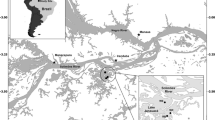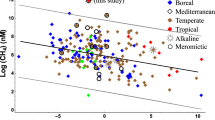Abstract
In the eastern part of Lake Constance, the second largest pre-alpine lake in Europe, about five hundred pockmarks (morphological depressions on the lake floor) were recently discovered of which ~40 % release methane bubbles. The carbon isotopic composition of the escaping gas indicated that the methane is of biogenic origin. In our study, we investigated the fate of the released methane bubbles, i.e., the dissolution, oxidation or transport of the bubbles to the surface. At a littoral pockmark site (PM12, 12 m water depth) and a profundal pockmark (PM80, 80 m water depth), we analysed the dissolved methane concentrations and the methane isotopic carbon signature in the water column. At PM80, higher methane concentrations (up to 1,523 nM), compared to the control site and the surface waters (225 ± 72 nM), were recorded only on some occasions and only in the bottom water, despite the fact that the released bubbles were dissolving within the hypolimnion based on bubble modeling. The isotope data suggest that most of the dissolved methane is oxidized below 40 m water depth. The isotopic signature of the methane in the surface water at PM80, however, differed from that of the methane in the hypolimnion; therefore, the surface methane at this profundal site is most likely an export product from the littoral zone. Assuming an initial bubble diameter of 5 mm, we calculated that these small bubbles would reach the surface, but approximately 96 % of the methane would have dissolved from the bubble into the hypolimnion. At PM12, we observed higher concentrations of dissolved methane (312 ± 52 nM) with no significant differences between seasons or between control sites versus pockmark site. In the shallow water, divers estimated the bubble size to be 10–15 mm, which from a release depth of 12 m would barely dissolved into the water column. The isotopic signature also indicated that there had been almost no methane oxidation in the shallow water column. Thus, the water depth of bubble release as well as the initial bubble size determine whether the methane enters the atmosphere largely unhindered (shallow site) or if the released methane is incorporated into the profundal water column.





Similar content being viewed by others
References
Baraza J, Ercilla G (1996) Gas-charged sediments and large pockmark-like features on the Gulf of Cadiz slope (SW Spain). Mar Pet Geol 13:253–261
Bastviken D, Ejlertsson J, Sundh I, Tranvik L (2002) Measurement of methane oxidation in lakes: a comparison of methods. Environ Sci Technol 36:3354–3361
Bastviken D, Cole J, Pace M, Tranvik L (2004) Methane emissions from lakes: dependence of lake characteristics, two regional assessments, and a global estimate. Glob Biogeochem Cycl 18: GB4009
Bastviken D, Cole JJ, Pace ML, Van de Bogert MC (2008) Fates of methane from different lake habitats: connecting whole-lake budgets and CH4 emissions. J Geophys Res 113: G02024
Bastviken D, Tranvik LJ, Downing JA, Crill PM, Enrich-Prast A (2011) Freshwater methane emissions offset the continental carbon sink. Science 331:50–50
Bäuerle E, Ollinger D, Ilmberger J (1998) Some meteorological, hydrological, and hydrodynamical aspects of Upper Lake Constance. Arch Hydrobiol Spec Issues Advanc Limnol 53:31–83
Boudreau BP, Gardiner BS, Johnson BD (2001) Rate of growth of isolated bubbles in sediments with a diagenetic source of methane. Limnol Oceanogr 46:616–622
Bussmann I (2005) Methane release through suspension of littoral sediment. Biogeochemistry 74:283–302
Bussmann I, Schlömer S, Schlüter M, Wessels M (2011) Active pockmarks in a large lake (Lake Constance, Germany): effects on methane distribution and turnover in the sediment. Limnol Oceanogr 56:379–393
Cathles LM, Su Z, Chen D (2010) The physics of gas chimney and pockmark formation, with implications for assessment of seafloor hazards and gas sequestration. Mar Pet Geol 27:82–91
Christodoulou D, Papatheodorou G, Ferentino G, Masson M (2003) The origin of two pockmark fields in Patras and Corinth Gulfs, Greece. Geo-Mar Lett 23:194–199
Coleman DD, Risatti JB, Schoell M (1981) Fractionation of carbon and hydrogen isotopes by methane-oxidizing bacteria. Geochim Cosmochim Acta 45:1033–1037
Craig H (1957) Isotopic standards for carbon and oxygen and correction factors for mass-spectrometric analysis of carbon dioxide. Geochim Cosmochim Acta 12:133–149
DelSontro T, McGinnis DF, Sobek S, Ostrovsky I, Wehrli B (2010) Extreme methane emissions from a Swiss hydropower reservoir: contribution from bubbling sediments. Environ Sci Technol 44:2419–2425
Eder M, Kobus H, Helmig R (2008) Three-dimensional modelling of hydrodynamics in Lake Constance. Wasserwirtschaft 98:16–21
Etiope G (2004) New directions: GEM—geologic emissions of methane, the missing source in the atmospheric methane budget. Atmos Environ 38:3099–3100
Gilfedder BS, Petri M, Wessels M, Biester H (2011) Bromine species fluxes from Lake Constance’s catchment, and a preliminary lake mass balance. Geochim Cosmochim Acta 75:3385–33401
Greinert J, McGinnis DF (2009) Single bubble dissolution model: the graphical user interface SiBu-GUI. Environ Model Software 24:1012–1013
Harrington PK (1985) Formation of pockmarks by porewater escape. Geo-Mar Lett 5:193–197
Hofmann H, Federwisch L, Peeters F (2010) Wave-induced release of methane: littoral zones as a source of methane in lakes. Limnol Oceanogr 55:1990–2000
Hovland M, Gardner JV, Judd AG (2002) The significance of pockmarks to understanding fluid flow processes and geohazards. Geofluids 2:127–136
IGKB (2004) Der Bodensee: Zustand - Fakten - Perspektiven. Internationale Gewässerschutzkommission, Bodensee
IGKB (2009) BUS—Bodensee-Untersuchung-Seeboden. Internationale Gewässerschutzkommission, Bodensee
IPCC, Denman KL, Brasseur G, Chidthaisong A, Ciais P, Cox PM, Dickinson RE, Hauglustaine D, Heinze C, Holland E, Jacob D, Lohmann U, Ramachandran S, Dias PLdS, Wofsy SC, Zhang X (2007) Couplings between changes in the climate system and biogeochemistry. In: Solomon S, Qin D, Manning M, Chen Z, Marquis M, Averyt KB, Tignor M, Miller HL (eds) Climate change 2007: the physical science basis. Contribution of working group i to the fourth assessment report of the intergovernmental panel on climate change. Cambridge University Press, Cambridge
Judd AG, Hovland M (2007) Seabed fluid flow: the impact of geology, biology, and the marine environment. Cambridge University Press, Cambridge
Kankaala P, Taipale S, Nykänen H, Jones RI (2007) Oxidation, efflux, and isotopic fractionation of methane during autumnal turnover in a polyhumic, boreal lake. J Geophys Res 112:G02033
McGinnis DF, Greinert J, Artemov Y, Beaubien SE, Wuest A (2006) Fate of rising methane bubbles in stratified waters: how much methane reaches the atmosphere? J Geophys Res (C Oceans) 111:C09007
Murase J, Sakai Y, Kametani A, Sugimoto A (2005) Dynamics of methane in mesotrophic Lake Biwa. Jpn Ecol Res 20:377–385
Ostrovsky I, McGinnis DF, Lapidus L, Eckert W (2008) Quantifying gas ebullition with echosounder: the role of methane transport by bubbles in a medium-sized lake. Limnol Oceanogr Methods 6:105–118
Paull CK, Ussler III W, Borowski WS, Spiess FN (1995) Methane-rich plumes on the Carolina continental rise: associations with gas hydrates. Geology 23:89–92
Paull C, Ussler III W, Maher N, Greene HG, Rehder G, Lorenson T, Lee H (2002) Pockmarks off Big Sur, California. Mar Geol 181:323–335
Sansone FJ, Holmes ME, Popp BN (1999) Methane stable isotopic ratios and concentrations as indicators of methane dynamics in estuaries. Glob Biogeochem Cycl 13:463–474
Schmid M, De Batist M, Granin N, Kapitanov V, McGinnis D, Mizandrontsev I, Obzhirov A, Wueest A (2007) Sources and sinks of methane in Lake Baikal: a synthesis of measurements and modeling. Limnol Oceanogr 52:1824–1837
Schmidt U, Conrad R (1993) Hydrogen, carbon monoxide, and methane dynamics in Lake Constance. Limnol Oceanogr 38:1214–1226
Schulz M, Faber E, Hollerbach A, Schröder HG, Güde H (2001) The methane cycle in the epilimnion of Lake Constance. Arch Hydrobiol 151:157–176
Soter S (1999) Macroscopic seismic anomalies and submarine pockmarks in the Corinth-Patras rift, Greece. Tectonophysics 308:275–290
Thebrath B, Rothfuss F, Whiticar MJ, Conrad R (1993) Methane production in littoral sediment of Lake Constance. FEMS Microbiol Ecol 102:279–289
von Deimling JS, Greinert J, Chapman NR, Rabbel W, Linke P (2010) Acoustic imaging of natural gas seepage in the North Sea: sensing bubbles controlled by variable currents. Limnol Oceanogr Methods 8:155–171
Wanninkhof R (1992) Relationship between wind speed and gas exchange over the ocean. J Geophys Res 97:7373–7382
Wessels M (1995) Bodensee-Sedimente als Abbild von Umweltänderungen im Spät- und Post-glazial. Göttinger Arb Geol Paläont 66:1–105
Wessels M, Bussmann I, Schloemer S, Schlüter M, Böder V (2010) Distribution, morphology, and formation of pockmarks in Lake Constance, Germany. Limnol Oceanogr 55:2623–2633
Whiticar MJ (2002) Diagenetic relationships of methanogenesis, nutrients, acoustic turbidity, pockmarks and freshwater seepages in Eckernförde Bay. Mar Geol 182:29–53
Acknowledgments
Many thanks are given to the scientific party and the crew of the R/V Kormoran. This study was supported by the German Research Foundation (BU966/3-1 and WE2210/2-1).
Author information
Authors and Affiliations
Corresponding author
Rights and permissions
About this article
Cite this article
Bussmann, I., Damm, E., Schlüter, M. et al. Fate of methane bubbles released by pockmarks in Lake Constance. Biogeochemistry 112, 613–623 (2013). https://doi.org/10.1007/s10533-012-9752-x
Received:
Accepted:
Published:
Issue Date:
DOI: https://doi.org/10.1007/s10533-012-9752-x




